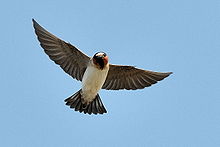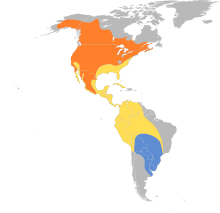| Cliff swallow | |
|---|---|

| |
| At Palo Alto Baylands NR, California, US | |
| Scientific classification | |
| Domain: | Eukaryota |
| Kingdom: | Animalia |
| Phylum: | Chordata |
| Class: | Aves |
| Order: | Passeriformes |
| Family: | Hirundinidae |
| Genus: | Petrochelidon |
| Species: | P. pyrrhonota
|
| Binomial name | |
| Petrochelidon pyrrhonota (Vieillot, 1817)
| |

| |
| Approximate distribution map
Breeding Migration Non-breeding
| |
| Synonyms | |
|
Petrochelidon lunifrons | |
The cliff swallow or American cliff swallow (Petrochelidon pyrrhonota) is a member of the passerine bird family Hirundinidae, the swallows and martins.[2] The generic name Petrochelidon is derived from the Ancient Greek petros meaning "stone" and khelidon (χελιδών) "swallow", and the specific name pyrrhonota comes from purrhos meaning "flame-coloured" and -notos "-backed".[3]
Cliff swallows are extremely social songbirds that can be found in large nesting colonies reaching over 2,000 nests.[2][4][5] They are frequently seen flying overhead in large flocks during migration, gracefully foraging over fields for flying insects or perching tightly together on a wire preening under the sun.[4]
Cliff swallows build gourd-shaped nests made from mud with small entrance holes.[2][4][6] They build their nests tightly together, on top of one another, under bridges or alongside mountain cliffs.[2][4] Living in large populations, these aerial insectivores use extensive vocalizations to communicate warnings or food availability to the other individuals.[4]
- ^ BirdLife International (2016). "Petrochelidon pyrrhonota". IUCN Red List of Threatened Species. 2016: e.T22712427A94333165. doi:10.2305/IUCN.UK.2016-3.RLTS.T22712427A94333165.en. Retrieved 12 November 2021.
- ^ a b c d Brown, Charles R.; Brown, Mary B.; Pyle, Peter; Patten, Michael A. (2017). "Cliff Swallow (Petrochelidon pyrrhonota)". The Birds of North America Online. doi:10.2173/bna.cliswa.03. S2CID 83748545.
- ^ Jobling, James A (2010). The Helm Dictionary of Scientific Bird Names. London: Christopher Helm. pp. 300, 327. ISBN 978-1-4081-2501-4.
- ^ a b c d e Brown, Charles R. (1998). Swallow summer. University of Nebraska Press. ISBN 978-0803261457. OCLC 38438988.
- ^ The Cornell Lab of Ornithology (2015). "Cliff Swallow". All About Birds. Retrieved October 4, 2017.
- ^ Sibley, David (2016). The Sibley Field Guide to Birds of Eastern North America (Second ed.). New York: Borzoi Books – Knopf. ISBN 9780307957917. OCLC 945096007.
